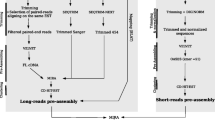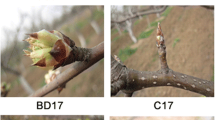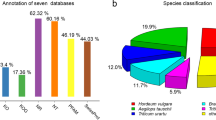Abstract
Substantial efforts have been invested in recent years to characterize the expressed genome of major North American spruce species, namely Sitka spruce (Picea sitchensis), white spruce (Picea glauca) and interior spruce (Picea engelmanii × glauca). To date, more than 550,000 spruce expressed sequence tags (ESTs) have been publically deposited, most of which were constructed from various tissue collected during active primary growth. Here we report EST sequencing of dormant foliage and bud tissue collected from Sitka spruce. Both normalized and standard libraries were employed, with tissue collected at two autumn time points. A total of 30,681 ESTs were generated then assembled into 9,400 putative unique transcripts, or unigenes, with an average length of 779 bp. These autumn specific Sitka spruce ESTs were combined with autumn specific white spruce ESTs and compared with all spruce ESTs currently available. In total, 12,307 ESTs were unique to the autumn libraries, which assembled into 11,121 unigenes. Functional categorization suggests a role for some of these genes in bud dormancy and adaptation to freezing stress. Our results show that dormant tissue harbours a large number of transcripts not found in the same tissue during the growing season, and this sequence resource will therefore support ongoing studies of adaptive traits in spruce.


Similar content being viewed by others
References
Ahuja MR, Neale DB (2005) Evolution of genome size in conifers. Silvae Genetica 54(3):126–137
Aitken SN, Yeaman S, Holliday JA, Wang T, Curtis-McLane S (2008) Adaptation, migration or extirpation: climate change outcomes for tree populations. Evolutionary Applications 1(1):95–111
Altschul SF, Madden TL, Schaffer AA, Zhang J, Zhang Z, Miller W, Lipman DJ (1997) Gapped BLAST and PSI-BLAST: a new generation of protein database search programs. Nucleic Acids Res 25(17):3389–3402
Asante DKA, Yakovlev IA, Fossdal CG, Holefors A, Opseth L, Olsen JE, Junttila O, Johnsen O (2011) Gene expression changes during short day induced terminal bud formation in Norway spruce. Plant Cell Environ 34(2):332–346
Ashburner M, Ball CA, Blake JA, Botstein D, Butler H, Cherry JM, Davis AP, Dolinski K, Dwight SS, Eppig JT, Harris MA, Hill DP, Issel-Tarver L, Kasarskis A, Lewis S, Matese JC, Richardson JE, Ringwald M, Rubin GM, Sherlock G (2000) Gene ontology: tool for the unification of biology. The gene ontology consortium. Nat Genet 25(1):25–29
Ausin I, Alonso-Blanco C, Jarillo JA, Ruiz-Garcia L, Martinez-Zapater JM (2004) Regulation of flowering time by FVE, a retinoblastoma-associated protein. Nat Genet 36(2):162–166
Bohlenius H, Huang T, Charbonnel-Campaa L, Brunner AM, Jansson S, Strauss SH, Nilsson O (2006) CO/FT regulatory module controls timing of flowering and seasonal growth cessation in trees. Science 312(5776):1040–1043
Chan SWL (2008) Inputs and outputs for chromatin-targeted RNAi. Trends Plant Sci 13(7):383–389
Cho SK, Kim JE, Park JA, Eom TJ, Kim WT (2006) Constitutive expression of abiotic stress-inducible hot pepper CaXTH3, which encodes a xyloglucan endotransglucosylase/hydrolase homolog, improves drought and salt tolerance in transgenic Arabidopsis plants. FEBS Lett 580(13):3136–3144
Dai X, Xu Y, Ma Q, Xu W, Wang T, Xue Y, Chong K (2007) Overexpression of an R1R2R3 MYB gene, OsMYB3R-2, increases tolerance to freezing, drought, and salt stress in transgenic Arabidopsis. Plant Physiol 143(4):1739–1751
Dauwe R, Holliday JA, Aitken SN, Mansfield SD (2012) Metabolic dynamics during autumn cold acclimation within and among populations of Sitka spruce (Picea sitchensis). New Phytol 194(1):192–205
Dharmasiri S, Swarup R, Mockaitis K, Dharmasiri N, Singh SK, Kowalchyk M, Marchant A, Mills S, Sandberg G, Bennett MJ, Estelle M (2006) AXR4 is required for localization of the auxin influx facilitator AUX1. Science 312(5777):1218–1220
El Kayal W, Allen CCG, Ju CJT, Adams E, King-Jones S, Zaharia LI, Abrams SR, Cooke JEK (2011) Molecular events of apical bud formation in white spruce, Picea glauca. Plant Cell Environ 34(3):480–500
Ewing B, Green P (1998) Base-calling of automated sequencer traces using PHRED II. Error probabilities. Genome Res 8(3):186–194
Ewing B, Hillier L, Wendl MC, Green P (1998) Base-calling of automated sequencer traces using PHRED I. Accuracy assessment. Genome Res 8(3):175–185
Griffith M, Yaish MW (2004) Antifreeze proteins in overwintering plants: a tale of two activities. Trends Plant Sci 9(8):399–405
Holliday JA, Ralph SG, White R, Bohlmann J, Aitken SN (2008) Global monitoring of autumn gene expression within and among phenotypically divergent populations of Sitka spruce (Picea sitchensis). New Phytol 178(1):103–122
Holliday JA, Ritland K, Aitken SN (2010) Widespread, ecologically relevant genetic markers developed from association mapping of climate-related traits in Sitka spruce (Picea sitchensis). New Phytol 188(2):501–514
Howe GT, Aitken SN, Neale DB, Jermstad KD, Wheeler NC, Chen THH (2003) From genotype to phenotype: unraveling the complexities of cold adaptation in forest trees. Canadian Journal of Botany-Revue Canadienne De Botanique 81(12):1247–1266
Howe GT, Gardner G, Hackett WP, Furnier GR (1996) Phytochrome control of short-day-induced bud set in black cottonwood. Physiol Plant 97(1):95–103
Huang XQ, Madan A (1999) CAP3: a DNA sequence assembly program. Genome Res 9(9):868–877
Imura Y, Kobayashi Y, Yamamoto S, Furutani M, Tasaka M, Abe M, Araki T (2012) CRYPTIC PRECOCIOUS/MED12 is a novel flowering regulator with multiple target steps in Arabidopsis. Plant and Cell Physiology 53(2):287–303
Joosen RVL, Lammers M, Balk PA, Bronnum P, Konings M, Perks M, Stattin E, Van Wordragen MF, van der Geest AHM (2006) Correlating gene expression to physiological parameters and environmental conditions during cold acclimation of Pinus sylvestris, identification of molecular markers using cDNA microarrays. Tree Physiol 26(10):1297–1313
Kolosova N, Miller B, Ralph S, Ellis BE, Douglas C, Ritland K, Bohlmann J (2004) Isolation of high-quality RNA from gymnosperm and angiosperm trees. Biotechniques 36(5):821–824
Lamesch P, Berardini TZ, Li D, Swarbreck D, Wilks C, Sasidharan R, Muller R, Dreher K, Alexander DL, Garcia-Hernandez M, Karthikeyan AS, Lee CH, Nelson WD, Ploetz L, Singh S, Wensel A, Huala E (2012) The Arabidopsis Information Resource (TAIR): improved gene annotation and new tools. Nucleic Acids Res 40:D1202–D1210. doi:10.1093/nar/gkr1090
Lee H, Suh SS, Park E, Cho E, Ahn JH, Kim SG, Lee JS, Kwon YM, Lee I (2000) The AGAMOUS-LIKE 20 MADS domain protein integrates floral inductive pathways in Arabidopsis. Genes Dev 14(18):2366–2376
Li CY, Junttila O, Ernstsen A, Heino P, Palva ET (2003) Photoperiodic control of growth, cold acclimation and dormancy development in silver birch (Betula pendula) ecotypes. Physiol Plant 117(2):206–212
Liu Q, Kasuga M, Sakuma Y, Abe H, Miura S, Yamaguchi-Shinozaki K, Shinozaki K (1998) Two transcription factors, DREB1 and DREB2, with an EREBP/AP2 DNA binding domain separate two cellular signal transduction pathways in drought- and low-temperature-responsive gene expression, respectively, in Arabidopsis. Plant Cell 10(8):1391–1406
Maere S, Heymans K, Kuiper M (2005) BiNGO: a Cytoscape plugin to assess overrepresentation of Gene Ontology categories in biological networks. Bioinformatics 21(16):3448–3449
Martz F, Sutinen ML, Kivineemi S, Palta JP (2006) Changes in freezing tolerance, plasma membrane H+-ATPase activity and fatty acid composition in Pinus resinosa needles during cold acclimation and de-acclimation. Tree Physiol 26(6):783–790
Olsen JE, Junttila O, Moritz T (1997a) Long-day induced bud break in Salix pentandra is associated with transiently elevated levels of GA(1) and gradual increase in indole-3-acetic acid. Plant and Cell Physiology 38(5):536–540
Olsen JE, Junttila O, Nilsen J, Eriksson ME, Martinussen I, Olsson O, Sandberg G, Moritz T (1997b) Ectopic expression of oat phytochrome A in hybrid aspen changes critical daylength for growth and prevents cold acclimatization. Plant Journal 12(6):1339–1350
Oquist G, Gardestrom P, Huner PA (2001) Metabolic changes during cold acclimation and subsequent freezing and thawing. In: Bigras FJ, Colombo SJ (eds) Conifer cold hardiness. Kluwer Academic, Dordrecht, pp 137–163
Pavy N, Paule C, Parsons L, Crow JA, Morency MJ, Cooke J, Johnson JE, Noumen E, Guillet-Claude C, Butterfield Y, Barber S, Yang G, Liu J, Stott J, Kirkpatrick R, Siddiqui A, Holt R, Marra M, Seguin A, Retzel E, Bousquet J, MacKay J (2005) Generation, annotation, analysis and database integration of 16,500 white spruce EST clusters. BMC Genomics 6:144
Penfield S (2008) Temperature perception and signal transduction in plants. New Phytol 179(3):615–628
Ralph SG, Chun HJE, Kolosova N, Cooper D, Oddy C, Ritland CE, Kirkpatrick R, Moore R, Barber S, Holt RA, Jones SJM, Marra MA, Douglas CJ, Ritland K, Bohlmann J (2008) A conifer genomics resource of 200,000 spruce (Picea spp.) ESTs and 6,464 high-quality, sequence-finished full-length cDNAs for Sitka spruce (Picea sitchensis). BMC Genomics 9(484)
Ramachandran V, Chen XM (2008) Small RNA metabolism in Arabidopsis. Trends Plant Sci 13(7):368–374
Rigault P, Boyle B, Lepage P, Cooke JEK, Bousquet J, MacKay JJ (2011) A white spruce gene catalog for conifer genome analyses. Plant Physiol 157(1):14–28
Rohde A, Bhalerao RP (2007) Plant dormancy in the perennial context. Trends Plant Sci 12(5):217–223
Rohde A, Prinsen E, De Rycke R, Engler G, Van Montagu M, Boerjan W (2002) PtABI3 impinges on the growth and differentiation of embryonic leaves during bud set in poplar. Plant Cell 14(8):1885–1901
Ruttink T, Arend M, Morreel K, Storme V, Rombauts S, Fromm J, Bhalerao RP, Boerjan W, Rohde A (2007) A molecular timetable for apical bud formation and dormancy induction in poplar. Plant Cell 19(8):2370–2390
Sakai A (1960) Survival of the twig of woody plants at −196°C. Nature 185(4710):393–394
Sasidharan R, Voesenek L, Pierik R (2011) Cell wall modifying proteins mediate plant acclimatization to biotic and abiotic stresses. Crit Rev Plant Sci 30(6):548–562
Schrader J, Moyle R, Bhalerao R, Hertzberg M, Lundeberg J, Nilsson P, Bhalerao RP (2004) Cambial meristem dormancy in trees involves extensive remodelling of the transcriptome. Plant Journal 40(2):173–187
Shannon P, Markiel A, Ozier O, Baliga NS, Wang JT, Ramage D, Amin N, Schwikowski B, Ideker T (2003) Cytoscape: a software environment for integrated models of biomolecular interaction networks. Genome Res 13(11):2498–2504
Smallwood M, Bowles DJ (2002) Plants in a cold climate. Philosophical Transactions of the Royal Society of London Series B—Biological Sciences 357(1423):831–846
Street NR, Skogstrom O, Sjodin A, Tucker J, Rodriguez-Acosta M, Nilsson P, Jansson S, Taylor G (2006) The genetics and genomics of the drought response in Populus. Plant Journal 48(3):321–341
Suzuki N, Mittler R (2006) Reactive oxygen species and temperature stresses: a delicate balance between signaling and destruction. Physiol Plant 126(1):45–51
Uemura M, Steponkus PL (1994) A contrast of the plasma membrane lipid composition of oat and rye leaves in relation to freezing tolerance. Plant Physiol 104(2):479–496
Uemura M, Tominaga Y, Nakagawara C, Shigematsu S, Minami A, Kawamura Y (2006) Responses of the plasma membrane to low temperatures. Physiol Plant 126(1):81–89
Weiser CJ (1970) Cold resistance and injury in woody plants. Science 169(3952):1269–1278
Yamazaki T, Kawamura Y, Minami A, Uemura M (2008) Calcium-dependent freezing tolerance in Arabidopsis involves membrane resealing via synaptotagmin (SYT1). Plant Cell 20(12):3389–3404
Acknowledgments
We would like to thank Tristan Gillan for technical assistance with plant maintenance. This research was funded by Genome British Columbia and Genome Canada supporting the Treenomix project (grant to JB and SA), the SMarTForests project (grant to JB) and the AdapTree project (grant to SA) and by a University of British Columbia Graduate Fellowship and NSERC Postgraduate Scholarship to JH. JB has been supported, in part, by the Distinguished University Scholars program of the University of British Columbia.
Data archiving statement
High-quality EST reads were submitted to NCBI under accession numbers ES667072 to ES671893, FD740103 to FD748148, GH280265 to GH291091 and GT120725 to GT127710. This resulting contig builds described here have been submitted to the Transcriptome Shotgun Assembly at DDBJ/EMBL/GenBank under the accession GACG00000000.
Author information
Authors and Affiliations
Corresponding author
Additional information
Communicated by L. Wegrzyn
Electronic supplementary material
Rights and permissions
About this article
Cite this article
Reid, K.E., Holliday, J.A., Yuen, M. et al. Sequencing of Sitka spruce (Picea sitchensis) cDNA libraries constructed from autumn buds and foliage reveals autumn-specific spruce transcripts. Tree Genetics & Genomes 9, 683–691 (2013). https://doi.org/10.1007/s11295-012-0584-6
Received:
Revised:
Accepted:
Published:
Issue Date:
DOI: https://doi.org/10.1007/s11295-012-0584-6




